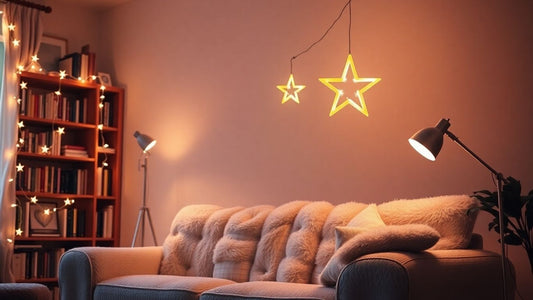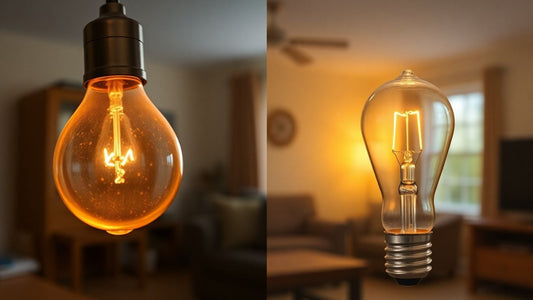Exploring Light Bulb Colour Temperature: How to Choose the Right Hue for Your Home
Choosing the right light bulb colour temperature can greatly influence the atmosphere and functionality of your home. Understanding the various options available can help you create the perfect setting for each room, enhancing both comfort and productivity.
Key Takeaways
- Colour temperature is measured in Kelvin, with lower numbers indicating warmer light and higher numbers indicating cooler light.
- Different rooms benefit from specific colour temperatures; for example, warmer lights are ideal for bedrooms while cooler lights suit kitchens.
- Energy-efficient bulbs, such as LEDs, come in a variety of colour temperatures, allowing you to replicate the warmth of incandescent bulbs.
- The right colour temperature can improve mood and productivity, making it important to choose wisely for each space.
- Always consider lumens and the Colour Rendering Index (CRI) when selecting bulbs, as these factors affect brightness and colour accuracy.
Understanding Light Bulb Colour Temperature
What is Colour Temperature?
Colour temperature refers to the appearance of light emitted by a bulb, measured in degrees Kelvin (K). It ranges from warm, yellowish light to cool, bluish light. For example, traditional incandescent bulbs typically emit a warm light around 2700K, while daylight bulbs can reach up to 6500K. Understanding this concept helps in selecting the right light for your home.
How Colour Temperature is Measured
Colour temperature is measured on a scale from 1,000K to 10,000K. The lower the number, the warmer the light. Here’s a quick reference:
| Light Source | Colour Temperature (K) |
|---|---|
| Candlelight | 2000 |
| Incandescent Bulb | 2700 |
| Halogen Bulb | 3000 |
| Cool White LED | 4000 |
| Daylight LED | 6000 |
The Kelvin Scale Explained
The Kelvin scale is essential for understanding light bulb colour temperature. Here are some key points:
- Warm Light (2000K-3000K): Ideal for bedrooms and living areas, creating a cosy atmosphere.
- Neutral Light (3500K-4100K): Suitable for kitchens and workspaces, providing a balanced feel.
- Cool Light (5000K-6500K): Best for task lighting, enhancing focus and alertness.
Choosing the right colour temperature can significantly affect the mood and functionality of your space. For instance, using the right E27 bulb colour temperature can enhance your home’s ambiance.
In summary, understanding light bulb colour temperature is crucial for creating the desired atmosphere in your home. Whether you prefer the warm glow of an incandescent or the bright clarity of an LED, knowing how to choose the right hue will help you achieve the perfect lighting.
The Impact of Colour Temperature on Your Home

Creating Ambiance with Light
Choosing the right colour temperature can greatly influence the atmosphere of your home. Warm lights (around 2700K) create a cosy and inviting feel, making them perfect for spaces like bedrooms and living rooms. In contrast, cooler lights (4000K and above) are ideal for areas where focus and alertness are needed, such as kitchens and home offices.
Choosing the Right Temperature for Each Room
Here’s a quick guide to help you select the best colour temperature for different rooms:
- Bedrooms: 2700K-3000K for a relaxing environment.
- Kitchens: 3000K-4000K to enhance visibility while cooking.
- Living Rooms: 3000K-3500K for a warm, inviting space.
- Bathrooms: 3000K-4000K for a fresh and clean feel.
Balancing Warm and Cool Lights
It’s essential to find a balance between warm and cool lights in your home. Here are some tips:
- Use warm lights in areas meant for relaxation.
- Opt for cooler lights in workspaces to boost productivity.
- Consider dimmable bulbs to adjust the light according to the time of day or activity.
The right colour temperature can transform your home, making it feel more comfortable and functional. Finding the perfect hue is key to enhancing your living space.
In summary, understanding how colour temperature affects your home can help you create the perfect atmosphere for every room. Whether you prefer the warmth of incandescent bulbs or the versatility of LEDs, knowing the right temperatures to use will make a significant difference in your living experience.
Comparing Different Types of Light Bulbs
When it comes to choosing the right light bulbs for your home, understanding the different types available is essential. Each type has its own unique features, benefits, and drawbacks. Here’s a breakdown of the most common types:
Incandescent vs LED
- Incandescent light bulbs are the traditional choice, providing a warm glow but are not very energy-efficient.
- LED light bulbs are more energy-efficient, last longer, and come in various colour temperatures. They can produce the same brightness as incandescent bulbs while using less power.
- Dimmable RGB smart bulbs offer versatility, allowing you to change colours and brightness through smart devices.
Energy Efficiency Considerations
| Bulb Type | Lifespan (Hours) | Energy Efficiency | Typical Wattage | Brightness (Lumens) |
|---|---|---|---|---|
| Incandescent | 1,000 | Low | 60-100 | 800-1600 |
| LED | 25,000 | High | 8-15 | 800-1600 |
| CFL | 10,000 | Moderate | 13-15 | 800-900 |
| Halogen | 2,000 | Moderate | 40-100 | 750-1600 |
Lifespan and Cost
- Incandescent bulbs are cheaper upfront but need frequent bulb replacement.
- LED bulbs have a higher initial cost but save money in the long run due to their longevity and energy efficiency.
- CFL bulbs are a middle ground, offering decent lifespan and efficiency but can take time to warm up.
Choosing the right light bulb can significantly impact your home’s energy consumption and atmosphere. Consider your needs carefully before making a decision!
How to Choose the Right Colour Temperature for Each Room
Best Temperatures for Bedrooms
When it comes to bedrooms, a warm light is essential for creating a relaxing atmosphere. The ideal colour temperature for bedrooms is between 2700K and 3750K. This range helps to promote a sense of calm and prepares you for sleep. Here are some tips for bedroom lighting:
- Use dimmable bulbs to adjust brightness.
- Consider using pendant lighting for a stylish touch.
- Avoid bright, cool lights that can disrupt your sleep cycle.
Optimal Lighting for Kitchens
Kitchens benefit from a brighter, more energising light. The recommended colour temperature is between 3800K and 4500K. This helps you stay alert while cooking and preparing meals. Here are some suggestions:
- Use cool white bulbs for task lighting.
- Install under-cabinet lights to brighten work areas.
- Ensure that your lighting is evenly distributed to avoid shadows.
Living Room Lighting Tips
For living rooms, a neutral light is often best, falling between 3800K and 4500K. This range creates a welcoming environment for relaxation and socialising. Consider these points:
- Combine warm and cool lights for balance.
- Use pendant lighting to create focal points.
- Opt for adjustable lighting to suit different activities, from reading to entertaining.
Choosing the right colour temperature can significantly enhance the mood and functionality of each room in your home. Remember to consider the activities that will take place in each space when selecting your bulbs.
Additional Factors to Consider When Choosing Light Bulbs
When selecting light bulbs for your home, there are several important factors to keep in mind to ensure you make the best choice for your needs.
Understanding Lumens and Brightness
- Lumens measure the brightness of a light bulb. The higher the lumens, the brighter the light.
- For example, a standard 60W incandescent bulb produces about 800 lumens.
- Consider the purpose of the room when choosing lumens; brighter lights are better for workspaces, while softer lights are ideal for relaxation areas.
The Importance of CRI (Colour Rendering Index)
- The Colour Rendering Index (CRI) indicates how accurately a light bulb displays colours compared to natural light.
- A CRI of 80 or above is generally considered good, while a CRI above 90 is excellent for vibrant colours.
- This is especially important in areas where colour accuracy is crucial, such as kitchens and art studios.
Energy Efficiency Labels
- Look for energy efficiency labels on light bulb packaging. These labels indicate how much energy the bulb uses.
- Bulbs rated A++ are the most efficient, while those rated E are the least efficient.
- Choosing eco-friendly light bulbs can help reduce your energy bills and environmental impact.
Remember, selecting the right light bulb goes beyond just brightness; consider lumens, CRI, and energy efficiency to create the perfect lighting for your home.
Additionally, consider options like motion sensor light bulbs for added convenience and energy savings. These bulbs can automatically turn on and off based on movement, making them ideal for areas like hallways and outdoor spaces.
Common Mistakes to Avoid When Selecting Light Bulbs

Ignoring Colour Temperature
One of the biggest mistakes people make is overlooking colour temperature when choosing light bulbs. Different temperatures can create various moods and atmospheres in your home. For instance, warmer temperatures (around 2700K) are great for relaxation, while cooler temperatures (above 4000K) are better for workspaces.
Overlooking Energy Efficiency
Another common error is not considering energy efficiency. Many people still opt for traditional incandescent bulbs, which are less efficient compared to modern options like LEDs. Here’s a quick comparison:
| Bulb Type | Lifespan (Hours) | Energy Efficiency | Typical Use |
|---|---|---|---|
| Incandescent | 1,000 | Low | General lighting |
| CFL | 10,000 | Moderate | General lighting |
| LED | 25,000 | High | General & task lighting |
Choosing the Wrong Bulb Type
Finally, selecting the wrong type of bulb for your fixtures can lead to disappointment. For example, B22 bulbs are popular for their versatility, but not all fixtures are compatible with them. Always check the specifications of your light fixtures before making a purchase.
Remember, the right light bulb can significantly enhance your home’s atmosphere and efficiency. Take your time to choose wisely!
The Benefits of Using the Right Colour Temperature
Improving Mood and Productivity
Choosing the right colour temperature can significantly affect how we feel and perform in a space. Warm light (2000-3000K) creates a cosy atmosphere, making it perfect for relaxing areas like bedrooms and living rooms. In contrast, cool light (4000-6500K) is energising and helps with focus, making it ideal for workspaces and kitchens.
Enhancing Home Decor
The right lighting can highlight your home’s features. For instance, warm white light accentuates wooden furniture and warm colours, while cool white light can make spaces feel more modern and vibrant. Here’s a quick guide:
- Warm White (2000-3000K): Best for bedrooms, living rooms, and dining areas.
- Cool White (4000-5000K): Ideal for kitchens, bathrooms, and workspaces.
- Neutral White (3900-4200K): Great for art displays and areas needing accurate colour representation.
Reducing Eye Strain
Proper lighting can also help reduce eye strain. Using the right colour temperature can make reading and working more comfortable.
Choosing the right colour temperature is not just about brightness; it’s about creating a space that feels right and works well for your needs.
In summary, selecting the appropriate colour temperature can transform your home, making it more inviting, functional, and visually appealing.
Using the right colour temperature can make a big difference in how a space feels. It can create a warm, inviting atmosphere or a cool, energising vibe, depending on what you need. If you want to learn more about how to choose the best lighting for your home or office, visit our website for helpful tips and products!
Final Thoughts on Choosing Light Bulb Colour Temperature
In conclusion, selecting the right colour temperature for your home is essential for creating the desired atmosphere in each room. Warmer lights, like those around 2700K, are perfect for areas where you want to feel relaxed, such as bedrooms and living rooms. On the other hand, cooler lights, typically above 4000K, are better suited for workspaces and kitchens where focus is key. By understanding the different colour temperatures and their effects, you can enhance both the look and feel of your home. Remember, it’s not just about brightness; it’s about how the light makes you feel. So take your time, explore your options, and choose wisely to create a space that truly reflects your style and needs.
Frequently Asked Questions
What is colour temperature in light bulbs?
Colour temperature describes how the light from a bulb looks. It can be warm, like candlelight, or cool, like daylight.
How do I measure the colour temperature of a light bulb?
Colour temperature is measured in Kelvin (K). Lower numbers, like 2700K, are warm, while higher numbers, like 6000K, are cool.
Which colour temperature is best for bedrooms?
For bedrooms, a warmer colour temperature around 2700K to 3000K is recommended to create a relaxing atmosphere.
Can I use LED bulbs to get a warm light?
Yes, you can choose LED bulbs that are designed to emit warm light, mimicking the glow of traditional incandescent bulbs.
What is the difference between lumens and watts?
Lumens measure how bright a light bulb is, while watts measure how much energy it uses. A bulb can be bright (high lumens) but use less energy (low watts).
Why is colour temperature important for my home?
Choosing the right colour temperature can affect how a room feels, its mood, and how well you can see, making it important for comfort and functionality.



